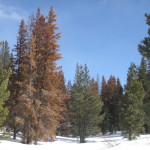Everything you know about forests is probably wrong
Posted: May 12, 2016Source: Journal Review

The problem is all the people who don’t understand the body of science behind timber management and who become highly agitated whenever they see trees being harvested. Not only are harsh words spoken but nowadays social media is leveraged, lawsuits get filed, protesters start waving signs and the whole process of scientific forest management becomes a front-page morality play featuring virtuous tree-huggers versus the evil timber industry.
In the middle of all this is Seifert, the Director of the Indiana Department of Natural Resources Division of Forestry. We recently took a hike in Morgan-Monroe State Forest near Martinsville with Siefert to learn about modern forestry management and how the Division of Forestry is really trying to enhance Indiana’s public woodlands rather than trying to turn it all into barrel staves and veneer.
One common misconception that has gained traction in some circles is that the state of Indiana is putting a chainsaw to every tree it can reach. While numbers show that timber harvest is indeed climbing, the whole thing needs to be placed into perspective.
“Harvesting is insignificant (on state land),” Siefert notes. “Right now, we’re only cutting about .01% of our tree inventory,” he said, “we’re banking more than we’re cutting. People also don’t realize that the majority of public land- parks, fish and wildlife areas, much federal land- is off-limits to timber harvest.”
Of course, leaving the trees alone to become “mature” forest should be the ultimate goal, right? Actually, that’s not the case.
Seifert points to the body of overwhelming scientific literature and experience which shows mature forest isn’t the biological Eden that people believe. In fact, data has shown that after a site is completely cut over, that habitat quality increases for about 10 years then steadily declines.
“As forests age, you tend to get less species diversity,” Seifert said. In fact, many endangered species or “species of special concern” depend on such “early successional forests” for hunting or nesting territory.
For example, the ruffed grouse depends on young forests. Ask an Indiana grouse hunter the last time they saw one as Indiana’s woodlands continue to age due to public pressure against timbering. Deer, turkey, songbirds, birds of prey and even reptiles such as box turtles and the endangered timber rattlesnake thrive in the cut-over areas.
“’No-harvest’ is the worse-case scenario for most species,” Siefert pointed out.
Of course, Seifert understands the visceral reaction people have to seeing mature trees dragged out of the forest or acres of beautiful woodland turned into a rutted field of broken limbs.
“Whenever we do that,” Siefert said, “the esthetics change dramatically but we know that in the forest floor there are literally thousands and thousands of seeds waiting to germinate and it’s all about the sunlight. When we renew that forest, we know within two or three growing seasons that forest will have ten to twenty-thousand new stems (of woody vegetation) per acre there. It’s really not an issue of science or biology, it’s the perception of the public,” he noted.
Siefert led us to a clear-cut area that is part of the Hardwood Ecosystem Experiment (HEE). HEE is a 100-year-long, multi-state research project to determine the impact of different harvesting methods. The goal is to “study every living thing within the HEE forest,” Siefert explained.
The 10-acre tract along the main forest road in Morgan-Monroe doesn’t offer much to see because the vegetation is so thick only a few years after a clear-cut. Blackberry vines claw as you walk along the trail while young yellow poplar, hackberry, cherry and even oak trees reach for the sky. Eventually, a solid canopy will develop and the species mix will change. During this evolving process, animals can find a smorgasbord of everything from fresh tender shoots to abundant insect life; at least until mature trees begin to dominate and food production starts to fall.
Ultimately, Siefert and his division aren’t in the business to chop down every tree in the forest. “It’s not really in our best interest to put any species in danger or not manage the forest sustainably. We are long-term thinkers, we think in decades rather than the next quarterly statement,” he said.
Our takeaway from the hike is this: everyone can agree that timber harvest, especially clear-cutting, isn’t pretty. However, such disturbances are critical to the health of Indiana’s forests and the people at the DNR Division of Foresty are working (against the current, it seems) to make healthier Hoosier woodlands for generations yet to come.
With better information, maybe Indiana outdoors enthusiasts can begin to support scientific timber management and see it for what it is: a key to strong, diverse forests.
